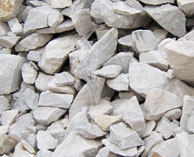
The mineral dolomite crystallizes in the trigonal-rhombohedral system. It forms white, gray to pink, crystals. Dolomite is a double carbonate, having a different structural arrangement, and it does not rapidly dissolve or effervesce (fizz) in dilute hydrochloric acid. A solid solution series exists between dolomite and iron rich ankerite. Small amounts of iron in the structure give the crystals a yellow to brown tint. Manganese substitutes in the structure also up to about three percent MnO. A high manganese content gives the crystals a rosy pink color noted in the image above. A series with the manganese rich kutnohorite may exist. Because dolomite can be dissolved by slightly acidic water, areas of dolomite are important as aquifers and contribute to karst terrain formation.
Recent research has found modern dolomite formation under anaerobic conditions in supersaturated saline lagoons along the Rio de Janeiro coast of Brazil, namely, Lagoa Vermelha and Brejo do Espinho. It is often thought, that dolomite will develop only with the help of sulfate-reducing bacteria.
Even so, the actual role of bacteria in the low-temperature formation of dolomite remains to be demonstrated in reproducible laboratory experiments. The specific mechanism of dolomite formation, involving for example sulfate-reducing bacteria, has not yet been documented.
Vast deposits of dolomite are present in the geological record, but the mineral is relatively rare in modern environments. Reproducible, inorganic low-temperature syntheses of dolomite and magnesite were published for the first time in 1999. Those laboratory experiments showed how the initial precipitation of a metastable "precursor" (such as magnesium calcite), will change gradually into more and more of the stable phase (such as dolomite or magnesite) during periodical intervals of dissolution and re-precipitation. The general principle governing the course of this irreversible geochemical reaction has been coined "breaking Ostwald's step rule".
Dolomite is used as an ornamental stone, a concrete aggregate, a source of magnesium oxide and in the Pidgeon process for the production of magnesium. It is an important petroleum reservoir rock, and serves as the host rock for large strata-bound Mississippi Valley-Type (MVT) ore deposits of base metals such as lead, zinc, and copper. Where calcite limestone is uncommon or too costly, dolomite is sometimes used in its place as a flux for the smelting of iron and steel. Large quantities of processed dolomite are used in the production of float glass.
The machine has high crushing ratio, high crushing efficiency and the rotor has a moment of inertia, energy consumption is low; with high chromium plate hammer, it has impact resistance,abrasion resistance, effectively extending the service life of the wearing parts.
The machine has a simple structure, which is mainly composed of a casing, a rotor and counterattack plate. The jacking device can quickly hit the rear frame to do the machine parts replacement repair operation. Rotor and the main shaft adopt expansion sleeve keyless connection. Maintenance is convenient, economic and reliable.
The machine is equipped with a top regulator outlet device, which can be simple and quick to adjust the counterattack plate and plate hammer clearance and control discharge size. The final products are in cube shape with no tension cracks and grain shape good, which is in line with various aggregate grading standards.

Supply the most current design and technical expertise; Supply parts sales and training service far beyond the initial sale; Your profits with quality parts and expert service.